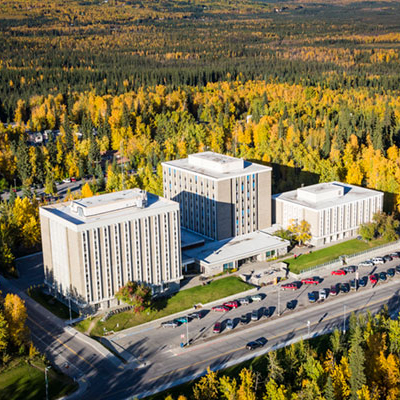Moore-Bartlett-Skarland Complex
1862, 1866, and 1876 Yukon Drive
 Photo by JR Ancheta, UAF University Relations
Photo by JR Ancheta, UAF University Relations
The Moore-Bartlett-Skarland complex includes three residence halls linked with a common area that includes the Hess Recreation Center, the Campus Cache and department offices.
In May 2023, contractors began work on a $27.5 million restoration of Moore and Bartlett halls. The two halls are expected to reopen in fall 2024. During the 2023-2024 academic year, students will be housed in the three residence halls along Denali Lane: Nerland, Stevens and McIntosh.
- Terris Moore Hall opened in 1966. The eight-story coed residence hall is the westernmost
building of the MBS complex. It is now one of two halls dedicated for first-year students.
The sixth floor is part of a living-learning community designed to support UAF's LGBTQ+
students. Named for former UA President Terris Moore in 1968, Moore Hall can house
up to 320 students. The main floor of Moore Hall contains two lounges, a classroom
and a kitchen area.
Terris Moore was the second president of the University of Alaska, serving from 1949 to 1953. Moore, with Sydney Chapman’s help, assembled a distinguished research staff at the Geophysical Institute and established the first formal graduate study at the university. He was granted emeritus status in 1972. - E.L. Bartlett Hall is the central building of the residential complex. The eight-story
building opened in 1969. Bartlett Hall has capacity for up to 322 students in single
and double occupancy rooms, with a lounge on each floor and a large lounge on the
ground floor. Bartlett offers gender-inclusive housing, consisting of rooms where students can live with any student — regardless of sex, gender, gender
identity or expression.
E.L. Bartlett, known as Bob, was born in Seattle, Washington, on April 20, 1904. He lived in Fairbanks from 1905 to 1933 and attended the Alaska Agricultural College and School of Mines and the University of Washington. Bartlett was named congressional secretary to Anthony J. Dimond, his close friend who had been elected Alaska's delegate to Congress in 1933. He succeeded Dimond and began the first of seven consecutive terms as Alaska's delegate to Congress. After Congress granted Alaska statehood, an act that Bartlett was instrumental in securing, he was elected U.S. senator and served in that post until his death in 1968. - Ivar Skarland Hall opened in 1964 as the "new women's dorm," to accommodate about
140 students in double and single rooms. The four-story hall was converted to coed in 1975. It is now one of two halls dedicated for first-year students. Skarland is home to
living-learning communities centered on honors studies, engineering, outdoor adventures
and civic engagement. Renovations were most recently completed in 2019. Skarland has lounges on the second and fourth floors, a laundry room on the third floor and
a large study hall on the ground floor.
Ivar Skarland, an immigrant from Norway, earned a bachelor's degree in anthropology from UA in 1935, then earned master's and doctoral degrees from Harvard. He returned to Fairbanks and taught from 1940 until his death in 1965. First as a student and later as a faculty member, he led development of the Nordic skiing trails that today lace North Campus. - The Harriet and Luther Hess Recreation Center opened in 1970, in the MBS Complex.
It was originally designed as a dining hall and called the Harriet and Luther Hess
Dining Commons. It currently serves as a meeting area for social events, conferences
and training sessions.
Harriet Belle moved to Fairbanks in 1907, where she was principal of the high school from 1907 to 1910. She married Luther Hess in 1911. She was elected secretary of the Board of Trustees of the Alaska Agricultural College and School of Mines upon its founding in 1917. She remained on the board when it became the University of Alaska Board of Regents in 1935 and served until her death in 1951.
Luther Hess was licensed to practice law in Alaska in 1901 and served as assistant U.S. district attorney for the Fourth Judicial Division until 1905. Hess served in nine sessions of the Alaska Territorial Legislature.


